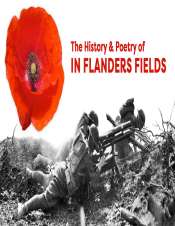
Objectives
- Students will learn about tetrameter and sonnets.
- Students will learn about the inspiration for McCrae's poem "In Flanders Fields."
Materials
Copies of "In Flanders Fields"
Procedures
- Do any of your students know why Veterans of Foreign Wars (VFW) volunteers give you a paper poppy after you give them a donation?
- Discuss Flanders Fields and the meaning of poppies to veterans. Here is an overview:
- Where are Flanders Fields?
Some of the bloodiest battles of World War I took place in the areas of northern France and southwest Belgium known as Flanders and Picardy. For a map of those areas, try out Google Maps or another mapping website.The British front line was determined to keep the Germans from traversing Flanders and the Ypres river valley to reach the port of Calais. Troops from both sides were holed up in the Ypres salient, an outward projection of the battle line. Defending British troops were vulnerable on three sides; therefore this was a bloody and dangerous place for a soldier to be.
The destruction from the battles in this area reached beyond the battlefield to the towns and roads of the area, and led to the demolition of buildings, roads, and all plant life, leaving only mud.
Where do the poppies come in?
Noticed as early as the Napoleonic Wars, red poppies grew on the graves of dead soldiers in the fields of northern Europe. Evidently, poppy seeds will lie underground for years and bloom if they are plowed up. In the spring of 1915, red poppies flourished in the fields of the Ypres salient covering the newly dug graves.Where does the poem come in?
The scenes of the spring battles in the Ypres salient moved John McCrae, a Canadian doctor, to write "In Flanders Fields." He wrote the poem as he sat in the dressing area (where wounds were dressed) looking out at a field of graves. The poem was later published in Punch Magazine. McCrae died of pneumonia in 1918, a common killer of Great War soldiers.Inspired by McCrae's poem, American Moina Michael wore poppies to honor the war dead. She also began to sell poppies to raise money for disabled veterans. After meeting Moina Michael in 1920, Frenchwoman Madame E. Guerin started selling handmade poppies to raise money for poor children who were living in the aftermath of the Great War. Soon thereafter Field-Marshall Earl Haig, the former British Commander-in-Chief, encouraged the selling of paper poppies to raise funds for veterans. This tradition spread to Canada and then to the United States.
- Read the poem aloud with your students.
- Looking at the content of the poem, ask your students to answer the following discussion questions.
- Compare the mood in the first two stanzas with that in the third.
- Is this a pro-war poem? If so why; if not, why not?
- Who is the speaker in this poem?
- What does the speaker want his listeners to do?
- Discuss tetrameter, a line of poetry with four metric feet.
- Reread the poem while stomping (with your feet) out the meter, saying each syllable so that they learn the rhythm of the poem.
- Discuss the structure of the poem. Although not technically a sonnet, "In Flanders Fields" borrows from that tradition.
- Information about sonnets:
- A sonnet is a 14-line poem, usually in iambic pentameter (5 metric feet, 10 syllables) with a strict rhyme scheme. Italian (Petrarchan) sonnets have an octave and a sestet, and have a rhyme scheme of abbaabba cdecde (the last sound of the last word in each line).Elizabethan (Shakespearean) sonnets consist of three quatrains and a couplet, and have a rhyme scheme of abab cdcd efef gg. The sonnet form is believed to have come from medieval songs.
Stanza—an arrangement of a certain number of lines, forming a division of a poem
Octave—An 8-line stanza
Sestet—A 6-line stanza
Quatrain—A 4-line stanza
Couplet—A 2-line stanza
Sonnet—A 14-line poem - Ask the class to find the rhyme scheme of the poem (aabba aabc aabbac).
- Why some would call it a sonnet when it does not follow traditional form?
Learn about the history behind "In Flanders Fields" while reviewing tetrameter and sonnet form. This is an excellent lesson to teach around Memorial or Veterans Day.




